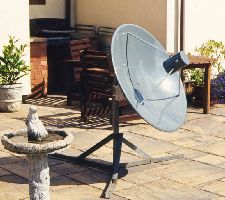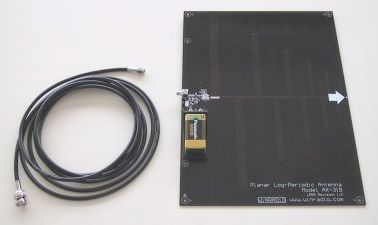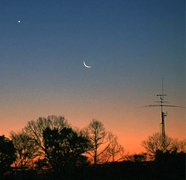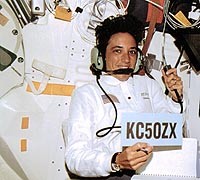Satellites reception
Notice
to fans of shortwaves (I)
Let's see what material is at our disposal to receive
transmissions from radio amateurs satellites and other orbital laboratories
(RS,
ISS, METEOSAT,
NOAA, INMARSAT, etc).
Like for radioastronomy,
a satellite receive system requires specific material that often counts among the accessories of a ham shack or the one of a listener.
Ce
document est disponible en français
Satellite
reception equipment
Let's
first define what constitutes a typical installation before considering other
solutions, more compact or integrated.
To be functional, generally speaking a basic station of satellite reception
requires basic material : a simple VHF antenna erected in an open space (not
to close to buildings), a receiver tuned on the same frequency, and some
meters of coaxial cable.
Cheapest solution
Here
is a cheap solution to receive weather satellites. The result is not guarantee
as the configuration is not optimized, and the signal is not poweful but you can
receive and decode images of weather satellites.
Several
accessories are for example available to Amazon or WiMo :
-
VHF receiver : RTL-SDR
receiver ($12.99)
-
VHF whip antenna : Tram
1185 dual-band antenna ($24.99) or Diamond
MR-77 avec connecteur PL (35 € to WiMo)
-
Coaxial cable M/F SMA to SO-239 : RF
coaxial cable ($5.70)
-
SDR software (free) : SDR console
for Windows or Cubic SDR for Mac OS X
-
Weather image processing software (free) : WXtoImg
for Windows and Mac OS X
-
Audio piping software (free) : VB-Audio
Virtual cable for Windows or Soundflower
for Mac OS X
-
A computer.
Total
cost : for less than $50 plus the computer you can already set up a receive installation !
NB.
If you have difficulties to find the antenna and the coaxial cable,
consult a shop dedicated to amateur radio
equipment.
We
will see next page specifications of RTL-SDR doggles and software.
Low
gain antennas
The
antenna must be cut on 137 MHz to receive polar orbiting satellites
(also named Polar Orbiting Environmental Satellites or POES). The
simplest but effective antenna is the turnstile or crossed
dipole (70-80 € to Thiecom
or Timestep),
the same as the one used on other frequencies by AM broadcasters but
at a smaller scale.
A
more efficient solution is to use the Quadrifilar
Helix Antenna (QHA or QFH). It has the advantage to be fixed, it does not
require a rotator, and changes automatically the elevation and azimuth
to the satellite direction without interruption. It is circularly
polarized and displays a relatively narrow bandwidth. If you are an
handyman you can easily build these antennas yourself at very low cost.
Unfortunately, blueprints are not easy to find and I don't have any.
At
last, there is the discone antenna. It is more suited to
terrestrial telecommunications but one can use it to
receive other signals, including satellites if they
cross the sky quite low over the horizon.
To
read : Quadrifilar Helix Antennas,
Gogan.org
Like
any antenna working on VHF bands, these aerials work without
preamplifier but require a good coaxial cable to prevent losses that
are more important on VHF than on HF. In this configuration the coax
length should not exceed 15 meters long. If your coaxial is 15 meters
or longer, you should use a 137 MHz preamplifier directly mounted
under the antenna. Such antennas also work fine to receive the ISS
signal on 145.800 MHz and for the 2-meter amateur band.
|

|
|
A Timestep
preamplifier to place just below the antenna. It has a low noise figure of 0.5 dB and a bandpass
filtering giving over 50 dB rejection to pagers on 153 MHz. |
In
addition we can use the next accessories :
-
An antenna preamplifier to increase receiving signals which power is limited to 5 W (37 dBm)
-
One or more SSB and FM receivers covering the frequencies of 30 MHz,
135-146 MHz (the most used), 430-440 MHz 1.691-1.694 kHz (for METEOSAT),
with frequency converters in option. For polar orbiting weather satellites
on 137 MHz you also need of an IF filter 30 to 50 kHz wide, neither
narrowest or wider.
-
A DSP modem (V.92 digital) to receive fax signals used by these
satellites and other transmissions by shortwaves (e.g. telemetry at
400 bps PSK from OSCAR satellites).
Usually,
receive signals from polar satellites is never a problem. Orbiting
between 200 km (ISS) and more than 1000 km of altitude, even with
5 W of power, you will pick up quite easily their signals. However,
orbiting much farther, geostationary satellites require a high gain antenna.
High
gain antennas
Knowing
that weather satellites work on various frequencies, we need several types of antennas. To receive weather
satellites on VHF you can use your turnstile or your Quadrifilar Helix
antenna. It is sufficient but displays a low gain. To receive METEOSAT you
also need something larger with narrower bandwidth and tuned on microwave (L-band).
This lead us to use high gain antennas, like next models :
|

|
|
A
90 cm Timestep dish to
receive geostationary satellites. It offers a 22.5 dBic gain
and 20 dB return loss. |
-
The cross-polarized VHF
Yagi (in X-shape) or the helical antenna (in corkscrew shape) with a right circular
polarization tuned on 137 MHz, and offering a gain over 14 dBic to receive signals
from weather satellites in polar orbit (NOAA, METEOR, etc) -
A dish antenna between 1 and 2m of diameter
(90 cm or 3 ft is the minimum) tuned on 1.69 GHz, offering a gain of at least
22 dBic and equipped with a low noise preamplifier to receive signals from geostationary satellites (METEOSAT, etc).
The
dish surface is either made of a plain metal plate or constituted of a simple
wire mesh. Some come with or without a sturdy tripod in
option. A high-end or tactical model can reach very high
prices but amateurs products are more accessible. Many
amateurs also rely on TV dishes.
These
two high gain antennas must be equipped with a rotator as their beam is very narrow (10-20°).
At
last, if you wish to use a satellite
tracking software to steer your antenna and track satellites in real
time, David H. Lamont, ZL2AMD, provides an UNI-TRAC
card, a tracking and tuning interface for PC that, connected
to a rotator, ensures a real time tracking on any satellite. This
interface replaces the Kansas
City Tracker/Tuner no more available.
All
these accessories are available to any good dealer of electronics or
ham material such as ICOM, Kenwood, Yaesu, AOR and other UKW-Berichte.
Most of them can provide you cross-polarized Yagis and dish antennas as well.
Compact
antennas

|
|
A
compact log periodic AX-31B antenna from WinRADIO able to receive
all frequencies between 230 MHz and 1600 MHz.
|
This rather cumbersome material, which must be installed outdoors, can scare beginners discovering this type of installation. Indeed, it changes
from the usual telescopic antenna of a portable radio!
But
we can go without this material. If you have few free space to install
several antennas or even to erect a vertical, a disk or a discone,
there is a "compact" solution that will please to listeners
and amateurs living in flats or apartments.
To
capture signals above 230 MHz, you can purchase to WinRADIO a
compact receive log periodic antenna and multiband AX-31B. It is a
beam not larger that a A4 sheet delivered with an included 20 dB
antenna amplifier and 2 metres of coaxial cable. It is a good
compromise and it also works indoor.
The
italien company PKW sells
also log periodic antennas for receive or transmission working in
different bands, e.g. the LP-22eV model covering from 130
MHz to 1.3 GHz (124 €).
Below 200 MHz,
if a 1 to 2 m long whip antenna can captures HF or VHF emissions within
a range of 100 to 1000 km depending on the frequency, this type of antenna is limited to a
relatively narrow frequency band and remains very sensitive to parasites
(noise) and all forms of local QRM.
In order
to reduce this inherent sensitivity of vertical antennas, Bonito (Ham Radio Shop)
sells two active magnetic loops consisting of a single wire forming a circle or a
square of 5 m in diameter able to receive all frequencies between 9 kHz and 200 MHz
(MegaLoop ML200, 369 €) or between 9 kHz and 180 MHz
(MegaLoop
FX, 399 €). This type of antenna does not even have to be placed outside; it can be
fixed on a balcony or on a window. Due to its small size, it is suitable for
a portable installation or a SDR dongle (see next page).
For the
LW and HF bands, Wellbrook also sells an active ALA-1530
(240 £) magnetic loop in aluminum measuring 1 m in diameter but covering only the
frequencies between 50 kHz and 30 MHz. It is as effective as a dipole to capture
amateur radio, coded messages and broadcast stations. It works also perfectly indoors.
However,
a magnetic loop is not a magic antenna. If this type of antenna is able of capturing
any type of signal (from broadcast stations, amateur, military, civilian services, etc.)
within a radius of about 10000 km or even more if the propagation is very good (during
the maximum of the solar cycle), this design is not as efficient as an rotatble Yagi
antenna cut at the working wavelength. Moreover, like any antenna, it is sensitive to
nearby broadcasting transmitters that can drown the weaker signals from far stations.
A magnetic loop is equivalent to the performance of a dipole while capturing less
noise, sources of interferences. Aluminium models are even steerable. Thus, from Europe,
for example, apart from the very powerful international radio transmitters (from Russia,
Brazil, Midwest, Central Africa, India, China, etc.) that can be picked up quite easily,
it is virtually impossible to capture emissions from local emitters located overseas,
in USA, South America, Asia or in the Pacific. To achieve this (and it is not even certain given
their low power), it would be necessary to install an external steerable HF or VHF
antenna tuned on the working frequency of theses emissions and to equip it with an amplifier
to guarantee a good reception.
Reception of ISS
If
you want only to listen to astronauts onboard the International Space
Station (ISS)
on VHF bands you can also simply use a ground plane vertical antenna or a discone.
This kind of antenna being vertically polarized, you can only pick up ISS transmissions
when it is low over the horizon and not as long as using a steerable
Yagi. Periods of interruption of amateur telecommunications are usually
scheduled, and related to EVA and crew changes.
To receive signals from
ISS, in Region 1 (Europe, Russia, Africa) you must listen to the frequency of
145.800 MHz in FM (downlink), radio amateurs operating from the ground
transmitting on 145.200 MHz (uplink).
Real
Time Satellite Tracking and Prediction
3-line
TLE of satellites (CelesTrak)
ISS
Fan Club - ISS
Latest TLE
Satellite
Tracking - TLE
of 5000 satellites (2006)
Reception
of videos from ISS
About
the direct reception of video images transmitted by ISS or from the space
shuttle to the Control center, it is vain to try. Indeed, signals are
transmitted via a satellite relay system named TDRS (Tracking & Data
Relay Satellite) which data are encrypted for security reasons. The
transmission is established in microwave band close to 15 GHz. At those
frequencies you need very exotic hardware and a lot of know-how to setup a
receive installation. If you are not a skilled telecom engineer, better to
give up... But if you need more information check the website of UHF-Satcom
or join the Amateur
DSN Group on Yahoo!
Reception
of HF-FAX
To
receive fax and other weather messages in HF bands (80-10m), you can tight
oudoor some 20m of electrical wire or erect a vertical antenna of about
6 m high or longer (cut at 1/4l).
A more expensive but more compact solution is to use an active receive magnetic loop
like Wellbrook ALA-1530 that works indoors too.
Real
Time Position of Amateur Satellites over Europe
AMSAT
Pass Prediction Calculator
(Online
predictions valid for all radio amateur satellites)
Heavens-Above
- Spaceweather
|
Amateur
radio activities |
 |
 |
|
At left,
we recognize a amateur radio to the large decametric Yagi erected close
to his home, and on which directional elements were added for
the V/UHF traffics. This picture was recorded on January 27, 1998 at the time of the
conjunction of the Moon with Venus and Mercury. At right, the
astronaut Nancy J.Currie, KC50ZX, onboard the US space shuttle in
QSO with hams at Goddard Amateur Radio Club on 145.200/145.800 MHz.
ISS crew works also in packet radio on 2m. Documents
Astroarts and NASA. |
|
In
the same way, if you are amateur radio and want to work by satellite (with
AMSAT or ISS) on adequate frequencies, your antenna should be quite performing
and idealy you should use a beam, these famous
array antennas using in VHF between 5-30 elements. In this application
they are used in crossed-polarization, equipped with an antenna
preamp (20 dB) and usually two coaxials, one of excellent quality
for transmission, the second that can be of lower quality for receive,
cables being as short as possible. There are till other differences
whether you work in SSB or FM. A short beam covering continuoulsy bands
from 1.5 to 200 MHz at 1 kW PEP is D2T.
But this is another debate.
Reception
of Inmarsat
For
all fans of maritime activities and adventure, recall that today no
expedition, that it is maritime, at ground or evolving in the air does
communicate by shortwaves, excepted local contacts in VHF. A the time
of satellites, all telecommunications between the crew and the base or
the HQ are established using the global network of Inmarsat satellites
and other Orbcomm (excepted in polar regions). Established
in 1979, Inmarsat uses today 13 satellites. They ensure all mobiles
communications world-wide. Inmarsat satellites are located on four
orbital spots named IOR, AORE,
AORW and POR. An Inmarsat link can be done using very modest but
expensive means, including a portable PC, an Inmarsat Mini-M telephone
(similar to a GSM) and a portable antenna. For information, a portable
Inmarsat installation for transmission (Inmarsat M4 terminal, Nera
console with a folding antenna and ISDN connection) cost $4000,
but this is something else than a GSM !
To
check : World at Phone
Inmarsat
satellites are divided in 4 categories depending on their functions or
supported modes : A (analog), B (digital), C (telex function) and D
(telecopy and telephony).
The
first satellite of this category is Inmarsat-A that is operational
since 1982. It transmits non-encrypted communications, including fax,
data and email. Its successor Inmarsat-B is operational since 1993 and
reduced the price of communications. Inmarsat-E transmits positions of
beacons for safety purposes and relies the information to coastal
Inmarsat stations, etc.
Connected
to Inmarsat global network, you can hear all crews at sea,
transatlantic liners, some business men and many scientific
expeditions. Inmarsat is also used in remote countries linking
students with their teacher. At last, through the ISDN network and an
Inmarsat GAN terminal, you can be connected to the Inmarsat though the
Internet.
To
listen to these transmissions, all you need is a receiver (scanner)
and an antenna tuned on L-band on 1525-1559 MHz (transmission on
1626.6-1660.5 MHz). Signals being emitting at low power, here also a
20 dB antenna preamplifier showing a low noise figure (0.5 dB) is
recommanded. The antenna can be either a dish offering a gain of at
least 20 dBic (or 10 dBic for a Mini-M) or an helical antenna right
circulary polarized.
If
you want to pick up these satellites when they are low over the
horizon (as to some boats) an omnidirectional antenna tuned on L-band
can be used.
Note
at last that most Inmarsat antennas can be used to receive weather
satellites in polar orbit (GOES, etc).
Reception
of Iridium
List
for memory the Iridium constellation of 66 satellites (Low-Earth
Orbit) orbiting at about 780 km of altitude. They work on Ka-band
(19.4-19.6 GHz downlink and 29.1-29.3 GHz uplink) and use L-band
(1616-1626.5 MHz) for telephony servicesas well as Ka-band
(23.18-23.38 GHz) for inter-satellites links. This newtork is
basically used to ensure communications in rural and maritime areas
where terrestrial links are non-existent. The Iridium networ transmits
also data and can be linked to any computer and to the Internet. At
last, Iridium offers Pager services permitting to receive and send
messages, emails and SMS anywhere in the world.
Excepted
L-band, the Iridium network is thus not available on a common scanner.
It requires downconverters and high gain dishes, reserving this type
of listening to skilled handymen able to build their own receive
installation.
Reception of NASA TV
NASA's Johnson
Space Center broadcasts 24 hours a day educative documents and reports of
current space missions, essentially on the geostationnary AMC-6 satellite located at 72°
West. This is a standard TV satellite transmitting two signals
: a video signal vertically polarized in NTSC format on C-band at 3880
MHz, and an audio FM monaural audio signal on a subcarrier of 6.8 MHz.
There
is also the NASA Television's Public and Media channels carried by QPSK/DVB-S
modulation on satellite AMC-3, transponder 15C, located at 87° West. The
downlink frequency is 4000 MHz, horizontal polarization, and MPEG-2 digital
C-band signals.
Note
that a Digital Video Broadcast (DVB) compliant Integrated Receiver Decoder (IRD) is needed for reception.
Knowing that the signal reaches 40 dBW over New
York but is 1000 times weaker in the middle of the North Atlantic
ocean, its receive from Europe requires a high gain dish (diam. > 4 m)
equipped with an antenna preamplifier and a NTSC/PAL or SECAM decoder but
the result is not guaranted.
So if your signal contour is 0 dBW in Europe, you are 40 dB
down. Knowing that the dish gain increases of only 6 dB each time you double the
diameter, you need a dish 64 times the diameter of the 40 dBW contour dish
(thus 64x 2 m or 128 m) to yield the same signal quality ! Hopefully, if
you visit the USA, you can easily receive this channel.
Remember that these transmissions are also accessible with
much less ressources on the Internet
and extracts can be donwloaded from various websites (Spacelink,
space.com, CNN, etc).
Second part
Reception
of weather images
|